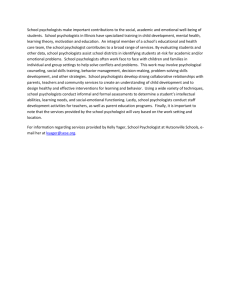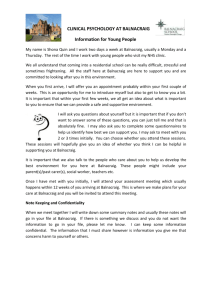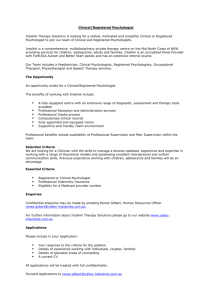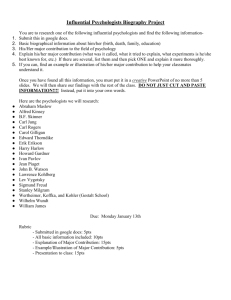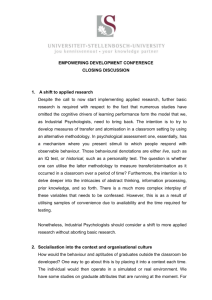Ethical Guidelines for Animals
advertisement
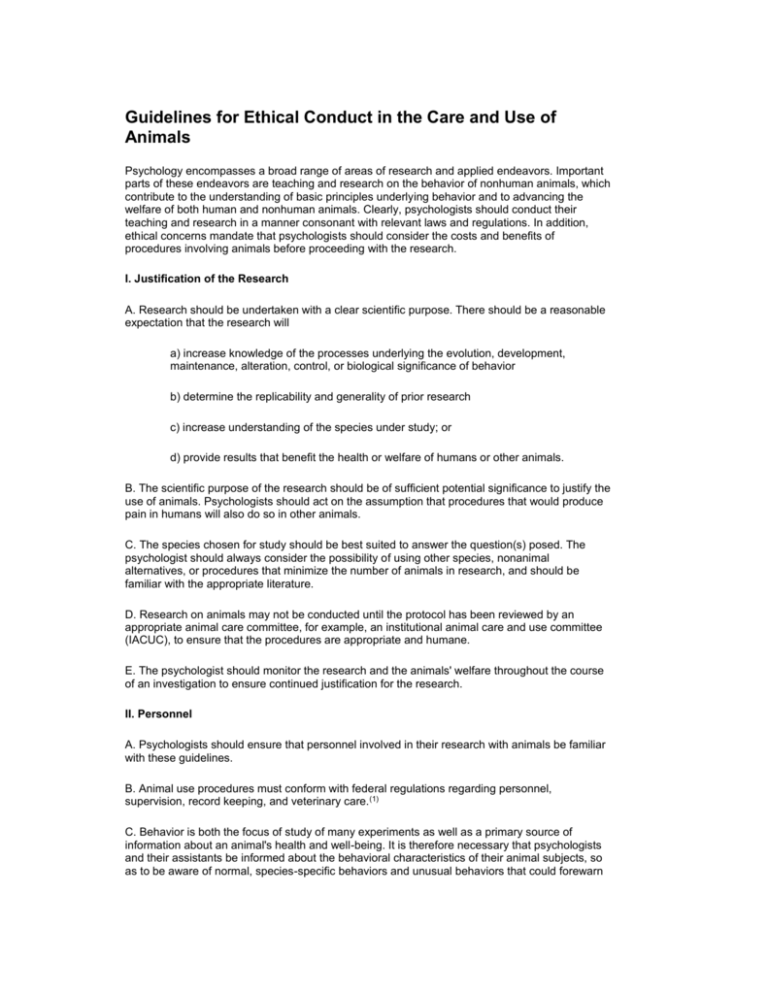
Guidelines for Ethical Conduct in the Care and Use of Animals Psychology encompasses a broad range of areas of research and applied endeavors. Important parts of these endeavors are teaching and research on the behavior of nonhuman animals, which contribute to the understanding of basic principles underlying behavior and to advancing the welfare of both human and nonhuman animals. Clearly, psychologists should conduct their teaching and research in a manner consonant with relevant laws and regulations. In addition, ethical concerns mandate that psychologists should consider the costs and benefits of procedures involving animals before proceeding with the research. I. Justification of the Research A. Research should be undertaken with a clear scientific purpose. There should be a reasonable expectation that the research will a) increase knowledge of the processes underlying the evolution, development, maintenance, alteration, control, or biological significance of behavior b) determine the replicability and generality of prior research c) increase understanding of the species under study; or d) provide results that benefit the health or welfare of humans or other animals. B. The scientific purpose of the research should be of sufficient potential significance to justify the use of animals. Psychologists should act on the assumption that procedures that would produce pain in humans will also do so in other animals. C. The species chosen for study should be best suited to answer the question(s) posed. The psychologist should always consider the possibility of using other species, nonanimal alternatives, or procedures that minimize the number of animals in research, and should be familiar with the appropriate literature. D. Research on animals may not be conducted until the protocol has been reviewed by an appropriate animal care committee, for example, an institutional animal care and use committee (IACUC), to ensure that the procedures are appropriate and humane. E. The psychologist should monitor the research and the animals' welfare throughout the course of an investigation to ensure continued justification for the research. II. Personnel A. Psychologists should ensure that personnel involved in their research with animals be familiar with these guidelines. B. Animal use procedures must conform with federal regulations regarding personnel, supervision, record keeping, and veterinary care.(1) C. Behavior is both the focus of study of many experiments as well as a primary source of information about an animal's health and well-being. It is therefore necessary that psychologists and their assistants be informed about the behavioral characteristics of their animal subjects, so as to be aware of normal, species-specific behaviors and unusual behaviors that could forewarn of health problems. D. Psychologists should ensure that all individuals who use animals under their supervision receive explicit instruction in experimental methods and in the care, maintenance, and handling of the species being studied. Responsibilities and activities of all individuals dealing with animals should be consistent with their respective competencies, training, and experience in either the laboratory or the field setting. III. Care and Housing of Animals The concept of psychological well-being of animals is of current concern and debate and is included in Federal Regulations (United States Department of Agriculture [USDA], 1991). As a scientific and professional organization, APA recognizes the complexities of defining psychological well-being. Procedures appropriate for a particular species may be inappropriate for others. Hence, APA does not presently stipulate specific guidelines regarding the maintenance of psychological well-being of research animals. Psychologists familiar with the species should be best qualified professionally to judge measures such as enrichment to maintain or improve psychological well-being of those species. A. The facilities housing animals should meet or exceed current regulations and guidelines (USDA, 1990, 1991) and are required to be inspected twice a year (USDA, 1989). B. All procedures carried out on animals are to be reviewed by a local animal care committee to ensure that the procedures are appropriate and humane. The committee should have representation from within the institution and from the local community. In the event that it is not possible to constitute an appropriate local animal care committee, psychologists are encouraged to seek advice from a corresponding committee of a cooperative institution. C. Responsibilities for the conditions under which animals are kept, both within and outside of the context of active experimentation or teaching, rests with the psychologist under the supervision of the animal care committee (where required by federal regulations) and with individuals appointed by the institution to oversee animal care. Animals are to be provided with humane care and healthful conditions during their stay in the facility. In addition to the federal requirements to provide for the psychological well-being of nonhuman primates used in research, psychologists are encouraged to consider enriching the environments of their laboratory animals and should keep abreast of literature on well-being and enrichment for the species with which they work. IV. Acquisition of Animals A. Animals not bred in the psychologist's facility are to be acquired lawfully. The USDA and local ordinances should be consulted for information regarding regulations and approved suppliers. B. Psychologists should make every effort to ensure that those responsible for transporting the animals to the facility provide adequate food, water, ventilation, space, and impose no unnecessary stress on the animals. C. Animals taken from the wild should be trapped in a humane manner and in accordance with applicable federal, state, and local regulations. D. Endangered species or taxa should be used only with full attention to required permits and ethical concerns. Information and permit applications can be obtained from: Fish and Wildlife Service V. Experimental Procedures Humane consideration for the well-being of the animal should be incorporated into the design and conduct of all procedures involving animals, while keeping in mind the primary goal of experimental procedures--the acquisition of sound, replicable data. The conduct of all procedures is governed by Guideline I. A. Behavioral studies that involve no aversive stimulation to, or overt sign of distress from, the animal are acceptable. These include observational and other noninvasive forms of data collection. B. When alternative behavioral procedures are available, those that minimize discomfort to the animal should be used. When using aversive conditions, psychologists should adjust the parameters of stimulation to levels that appear minimal, though compatible with the aims of the research. Psychologists are encouraged to test painful stimuli on themselves, whenever reasonable. Whenever consistent with the goals of the research, consideration should be given to providing the animals with control of the potentially aversive stimulation. C. Procedures in which the animal is anesthetized and insensitive to pain throughout the procedure and is euthanized before regaining consciousness are generally acceptable. D. Procedures involving more than momentary or slight aversive stimulation, which is not relieved by medication or other acceptable methods, should be undertaken only when the objectives of the research cannot be achieved by other methods. E. Experimental procedures that require prolonged aversive conditions or produce tissue damage or metabolic disturbances require greater justification and surveillance. These include prolonged exposure to extreme environmental conditions, experimentally induced prey killng, or infliction of physical trauma or tissue damage. An animal observed to be in a state of severe distress or chronic pain that cannot be alleviated and is not essential to the purposes of the research should be euthanized immediately. F. Procedures that use restraint must conform to federal regulations and guidelines. G. Procedures involving the use of paralytic agents without reduction in pain sensation require particular prudence and humane concern. Use of muscle relaxants or paralytics alone during surgery, without general anesthesia, is unacceptable and should be avoided. H. Surgical procedures, because of their invasive nature, require close supervision and attention to humane considerations by the psychologist. Aseptic (methods that minimize risks of infection) techniques must be used on laboratory animals whenever possible. All surgical procedures and anesthetization should be conducted under the direct supervision of a person who is competent in the use of the procedures. If the surgical procedure is likely to cause greater discomfort than that attending anesthetization and unless there is specific justification for acting otherwise, animals should be maintained under anesthesia until the procedure is ended. Sound postoperative monitoring and care, which may include the use of analgesics and antibiotics, should be provided to minimize discomfort and to prevent infection and other untoward consequences of the procedure. Animals cannot be subjected to successive surgical procedures unless these are required by the nature of the research, the nature of the surgery, or for the well-being of the animal. Multiple surgeries on the same animal must receive special approval from the animal care committee. When the use of an animal is no longer required by an experimental protocol or procedure, in order to minimize the number of animals used in research, alternative uses of the animals should be considered. Such uses should be compatible with the goals of research and the welfare of the animal. Care should be taken that such an action does not expose the animal to multiple surgeries. J. The return of wild-caught animals to the field can carry substantial risks, both to the formerly captive animals and to the ecosystem. Animals reared in the laboratory should not be released because, in most cases, they cannot survive or they may survive by disrupting the natural ecology. K. When euthanasia appears to be the appropriate alternative, either as a requirement of the research or because it constitutes the most humane form of disposition of an animal at the conclusion of the research: 1. Euthanasia shall be accomplished in a humane manner, appropriate for the species, and in such a way as to ensure immediate death, and in accordance with procedures outlined in the latest version of the American Veterinary Medical Association (AVMA) Panel on Euthanasia.(2) 2. Disposal of euthanized animals should be accomplished in a manner that is in accord with all relevant legislation, consistent with health, environmental, and aesthetic concerns, and approved by the animal care committee. No animal shall be discarded until its death is verified. VI. Field Research Field research, because of its potential to damage sensitive ecosystems and ethologies, should be subject to animal care committee approval. Field research, if strictly observational, may not require animal care committee approval (USDA, 1989, pg. 36126). A. Psychologists conducting field research should disturb their populations as little as possible-consistent with the goals of the research. Every effort should be made to minimize potential harmful effects of the study on the population and on other plant and animal species in the area. B. Research conducted in populated areas should be done with respect for the property and privacy of the inhabitants of the area. C. Particular justification is required for the study of endangered species. Such research on endangered species should not be conducted unless animal care committee approval has been obtained and all requisite permits are obtained (see IVD). VII. Educational Use of Animals Laboratory exercises as well as classroom demonstrations involving live animals can be valuable as instructional aids. APA has adopted separate guidelines for the educational use of animals in precollege education, including the use of animals in science fairs and demonstrations. For a copy of APA's Ethical Guidelines for the Teaching of Psychology in the Secondary Schools, write to: A. Psychologists are encouraged to include instruction and discussion of the ethics and values of animal research in all courses that involve or discuss the use of animals. B. Animals may be used for educational purposes only after review by a committee appropriate to the institution. C. Some procedures that can be justified for research purposes may not be justified for educational purposes. Consideration should be given to the possibility of using nonanimal alternatives.

